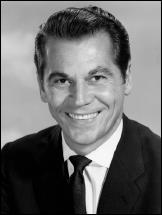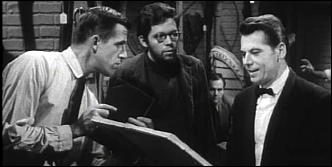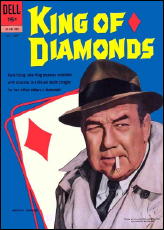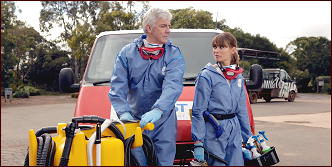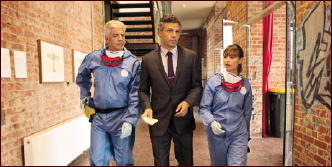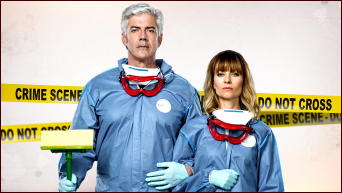THE AVENGERS BEFORE DIANA RIGG –
PART ONE: THE BEGINNINGS
by Michael Shonk.
THE AVENGERS, Seasons 1-2. ABC, (Associated British Corporation) Production for ITV, 1961-63. Patrick Macnee as John Steed (Seasons 1 and 2), Ian Hendry as Dr. David Keel (Season 1), Ingrid Hafner as Carol Wilson (Season 1), Julie Stevens as Venus Smith (Season 2), and Jon Rollason as Dr. Martin King (Season 2). Theme composed and performed by Johnny Dankworth. Produced by Leonard White (Seasons 1and 2), John Bryce (Season 2).

The recent death of Patrick Macnee had me and anyone else who has watched TV in the last fifty years thinking about The Avengers. Most fans of the series, especially Americans, are familiar with Emma Peel and the later seasons of The Avengers, but not the early seasons. I have always been curious on what happened before Diana Rigg arrived.
It began with the failed British TV series Police Surgeon that starred the popular and talented actor Ian Hendry as Dr. Geoffrey Brent. ABC was looking for something different from the “realistic and gloomy plays†that currently filled the schedule. Originally plans were to spin-off the character Dr. Brent but for a variety of reasons it was decided to drop any connection the new series might have to Police Surgeon. ABC’s head of programming Sydney Newman and Police Surgeon producer Leonard White decided to create a new series around Ian Hendry. Newman, White and a group of production people and writers would create The Avengers, a hardboiled thriller with a dark sense of humor that starred Hendry as Dr. David Keel. Patrick Macnee was hired as spy John Steed in a supporting role. The only other connection The Avengers had to Police Surgeon was actress Ingrid Hafner who played Police Surgeon Nurse Amanda Gibbs and The Avengers Nurse Carol Wilson.

For years the episode “The Frighteners†was the only surviving episode from the first season (or in British terms the first series), but then the episode “Girl On the Trapeze†and the first act of the first episode “Hot Snow†were found in the UCLA TV/Film archive. It is not unusual now to find all three on YouTube in various conditions.
Despite the lack of actual episodes, today we know much more about the first season. Reconstructions of the missing programs can be found at Alan Hayes’ website “The Avengers Declassified.â€
There is also a book The Strange Case of the Missing Episodes – The Lost Stories of The Avengers, Series 1, by Richard McGinlay, Alan Hayes and Alys Hayes (Hidden Tiger, 2013) that examines each of the Season One episodes in detail. Another book by McGinlay and Alan Hayes, With Umbrella, Scotch and Cigarettes – An Unauthorized Guide to The Avengers Series 1 (Hidden Tiger, 2014) examines behind the scenes of the first season. (I highly recommend both books, especially With Umbrella… for more details about the series than I can fit in here.)

Also beloved audio producer Big Finish has begun to record audio recreations of the lost Season One episodes with Anthony Howell as Dr. Keel, Julian Wadham as John Steed and Lucy Briggs-Owen as Carol Wilson.
The series first three seasons were shot live on videotape and in black and white. Because of a lack of worthy scripts and to gain more time Season One episode three was broadcast live and that would continue until episode ten returned to live on videotape.
Because of the regional system of British TV, the actual airdates vary such as the first episode “Hot Snow†first aired in only two small regions (Midlands and North) on January 7, 1961 then in five other regions including London on March 18, 1961 and not transmitted at all in the final five regions. Because of this I have left the airdate off the episodes reviewed below.
One note about the YouTube videos used here. Each is the best available at the moment, but the videos are marred by the unnecessary addition of a iris shape light in the center of the picture that was pointlessly added by whoever downloaded these episodes.
https://www.youtube.com/watch?v=8_CacBKW6zQ
“The Frighteners.†– Teleplay by Berkeley* Mather. Directed by Peter Hammond. Produced by Leonard White. Guest Cast: Willoughby Goddard, Philip Gilbert and Philip Locke. *** A rich father hires the Deacon and his “frighteners†to beat-up and scare off a man who wants to marry his daughter.
* On-screen typo for Berkely Mather (author of Pass Beyond Kashmir (1960). The book almost adapted for film by Bond producers to star Sean Connery and Honor Blackman.)
It is impossible to fairly critique this early episode after experiencing what would follow. Those who enjoy their crime melodrama’s hardboiled will enjoy this one. Ian Hendry turned in a fine performance as the reckless heroic Doctor Keel. But the series and Steed were still a work in progress. While Hendry was the star and the story focused on his character he was just one of many to assist the ruthless and flippant Steed. Perhaps the most noticeable difference between this The Avengers and those with Rigg was a lack of playfulness and fun.

The first season of The Avengers was a mild success but was cut short by an Equity (actors) strike at ITV that began November 1961 and lasted until April 1962. Only twenty-six episodes were completed when the strike shut down production. Producer Leonard White and the writing staff continued to work on possible changes to the series. White had hoped to do thirty-nine episodes for the first season. In late 1961 White began to make plans to add a new female character to the cast, a jazz singer named Venus Smith. She and Dr. Keel would alternate episodes as Steed’s partner.
As some point Ian Hendry broke his contract and left the series. Producer White would long hold out hope that Hendry might return if only for an occasional guest role.
In February 1962 while the actors were still on strike, White briefed the writers about Season Two and its characters – John Steed as the lead, Venus Smith and Cathy Gale as his partners who would alternated episodes, and One-Ten (one of the men to give Steed his instructions – played by Douglas Muir in five episodes).
The strike ended in April and The Avengers resumed production in May, despite not having yet cast the roles of Cathy Gale (Honor Blackman would get the part in June 1962) or Venus Smith. The first audition for the role of Venus was held in August 1962 and Angela Douglas (Carry On… film series) was hired. But then for some reason she was no longer available. A second audition was held August 31, 1962 and Julie Stevens was selected for the role of Venus Smith. But Steed needed some one to be his partner to resume shooting in May, and despite his hopes producer White finally realized Ian Hendry was not coming back.
Enter Dr. Martin King played by Jon Rollason. An obvious fill-in for Ian Hendry who was now off making movies, Rollason lacked the talent and wit of Hendry. He lasted only three episodes – “Mission To Montreal,†“Dead On Course,†and “The Sell-Out.†All three episodes made use of first season scripts written for Hendry’s Dr. David Keel, “Mission To Montreal†was originally “Gale Force,†“Dead On Course†was “The Plane Wreckers,†while “Sell-Out†kept its original title. Little was changed except the characters’ names with Dr. David Keel becoming Dr. Martin King and Keel’s Nurse Carol Wilson (Ingrid Hafner) replaced by Judy (played by Gillian Muir).
https://www.youtube.com/watch?v=zuiZBJPzGH8
“Mission To Montreal.†Teleplay by Lester Powell. Directed by Don Leaver. Produced by Leonard White. Guest Cast: Patricia English, Iris Russell, and Mark Eden. *** When a sex-symbol star’s stand-in is killed in her dressing room the terrified actress quits and takes a cruise to Montreal.
The episode was an average TV thriller about a cruise ship full of spies and various suspicious characters. While Rollason is instantly forgettable in the leading role, Macnee continued to make the callous Steed almost likable.
Poor Julie Stevens. She had a nice voice but lacked a great deal as a performer and actress. It was not her fault the writers failed so epically with the character of Venus Smith.
The idea of adding a jazz singer with the backdrop of the shady wicked world of the nightclub seemed to fit Steed’s work and the naughty second season. The additional music could enhance the current and popular soundtrack work of Johnny Dankworth. It would also allow more sexual situations, something both Newman and White wanted to add in the second season. Yet somehow they went from casting a CARRY ON girl as Venus Smith to inexperienced young Julie Stevens. Venus became a naïve not too bright twenty-year old – an anti-Mrs. Catherine Gale.
The writers seemed lost what to do with Venus. She seemed to exist to get in the way and need rescued. There are episodes when we wonder why Venus is even there. In “A Chorus of Frogs,†Steed involves Venus in a dangerous mission without asking just so he would have a cabin to stay in when he stows away on a ship. The Steed-Venus relationship is as creepy as Steed would ever get as he flirts with her then ruthlessly toss the clueless young girl into situations that could cost Venus her life.
Thankfully for all, Venus lasted only six episodes in the second season -“The Decapod,†“The Removal Man,†“Box of Tricks,†School of Traitors,†“Man In the Mirror,†and “A Chorus of Frogs.â€
https://www.youtube.com/watch?v=nlI_V0XigtU
“The Removal Man.†Teleplay by Roger Marshall and Jeremy Scott. Directed by Don Leaver. Produced by Leonard White. Guest Cast: Edwin Richfield, Patricia Denys, George Roderick and The David Lee Trio (David Lee: piano, Spike Heatley: double bass, and Art Morgan: drums). Recurring Cast: Douglas Muir as One-Ten. *** Steed goes undercover to stop a gang of hired killers with high profile targets. One-Ten and Steed have arranged to have the unsuspecting Venus get hired to sing at one of the gang member’s nightclub.
An above average hardboiled thriller with logic problems and an unlikable Steed. There is no real reason for Venus to be there except to sing and to have someone there to ruin undercover Steed’s plan. This episode is a good sample of the increased kinkiness of the second season with hints of nudity and sexual banter. The nightclub setting was underused and the music for the most part seemed to be filler for a too short script.
Venus’s music numbers were: “An Occasional Man†(by Ralph Blane and Hugh Martin – originally for the film Girl Rush, 1955), “I May Be Wrong “ (by Henry Sullivan and Henry Ruskin, 1929) and “Sing For Your Supper†(by Richard Rogers and Lorenz Hart – originally for stage play “The Boys of Syracuse,†1938).
David K. Smith’s website “Avengers Forever” has a cheeky essay from this episode co-writer Roger Marshall about writing for The Avengers and some of his co-workers such as Brian Clemens.
Producer Leonard White would leave the series during Season Two. Replacing White was John Bryce, one of the series story editors from the beginning. Executive Sydney Newman left to run BBC programming and help create Doctor Who and Adam Adamant Lives!
Steed’s third and main partner in Season Two would save the series. Next we will examine the story of Mrs. Catherine Gale as played by Honor Blackman.
